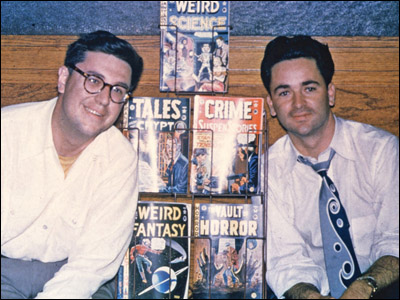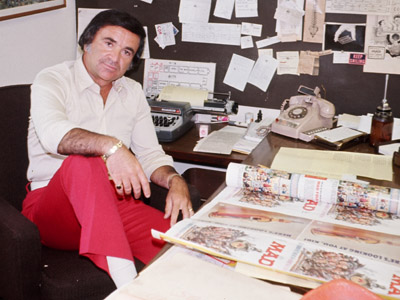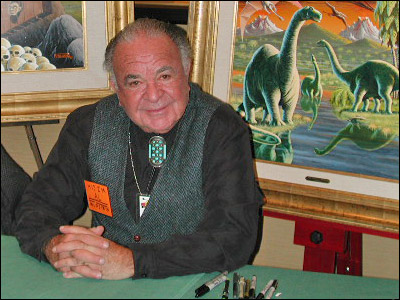When Al Feldstein died at the end of April, I was too swamped with work to write a long piece about him. Al was obsessive about meeting deadlines so I used that as an excuse to defer this piece.
Al was a fascinating, talented man whose career more or less divided into three acts…
Act One came when he was writer-editor of most of the EC Comics from 1948 to 1955. Before that, he was a journeyman comic book artist — not a particularly great one — who like most was trying to make a living in a business that seemed stacked against the guys who created the product. Publishers paid X dollars a page. An artist could, if he worked long hours, produce Y number of pages per week. X times Y was not a bad living wage…but it has never been the American Dream to be content with "not a bad living wage" for your entire life and how long can you work long hours, anyway?
It was especially not satisfactory to those who grew up, as Al did, in the Depression. Another of those men, a fine artist name Jim Mooney, said this to me one time in an interview…
If I put in a sixty hour week at the board, I could usually finish seven or eight pages a week. That's pencils and inks. That paid decently. I could support a family on that as long as my health didn't falter and the publisher didn't go under. I was nervous about relying on those two things. We all were. I wanted to get ahead, to get some cushion in the bank so I wouldn't be in trouble if the work suddenly stopped or if I got sick. Hell, I just wanted to be able to cut back to forty hours a week. But doing comics, there didn't seem to be a way.
That was the dilemma that Mooney faced, that Feldstein faced, that they all faced: How do you parlay this thing you can do into some sort of meaningful financial security? Feldstein took a giant step in that direction in the late forties when he connected with William M. Gaines, publisher of EC Comics. He became Gaines' main editor and they concocted one of the best-selling lines of comics at the time — Tales from the Crypt, Crime SuspenStories and all the rest. Gaines made money and some of that trickled down to Feldstein.

They were good comics, some of the finest ever done. And all time, Feldstein was looking for what he might do next, what might pay even better. Because like everyone, he wasn't content with just making a weekly wage. He wanted that cushion in the bank. He wanted to amass enough funds to see himself and his family through emergencies and for them to live better. He also thought it might be nice to have enough money that he could someday retire.
One of the interesting things to me about those comics is that all the artists in them signed their work. That was not true at any other comic company of the day. Some companies discouraged that but even at the ones that didn't care, most artists did not sign what they drew. EC did encourage it and even did little spotlight pages on their artists, promoting them.
Still, in marked contrast to what Stan Lee would do less than a decade later, Feldstein did not put his name on what he wrote. He authored something like 80% of the stories that ran in the comics he edited but he didn't slap "Written by Al Feldstein" on any of them in the color comics. He mentioned it from time to time deep in the letter pages so it wasn't a secret. He just didn't call a lot of attention to that because, you know, that was just his current job.
He had fantasies of getting into something else, perhaps some other form of publishing that paid a lot better and offered more possibilities of getting rich. Maybe, if and when that opportunity presented itself, he'd want people to forget he'd written The Vault of Horror. There were some best-selling novelists around then who quietly omitted from their bios that they'd once scripted comic books for a few bucks a page. There were also those people in the world who felt that whoever was behind those horrible horror comics should be in jail.
Act One of the Feldstein story ended when the horror and crime comics did…when political, societal and mostly business pressures forced those comics off the racks. Reluctantly — because Gaines treated his employees like family members — he let Feldstein go. Al went off to try and sell novels and TV scripts and to just find anything.
Act Two was all about MAD. Harvey Kurtzman was MAD's first editor and MAD was the only surviving remnant of Gaines's publishing empire after the comics went away. It was a magazine and it was a successful magazine but it wasn't coming out on time. Kurtzman was a slow, almost obsessive worker who'd spend days to get one page just the way he wanted it. Deadlines came and went with no issue of MAD going off to the printer.
He also had problems with the way Gaines ran the company. Emboldened by an offer from Hugh Hefner, Kurtzman went to Gaines and demanded 51% of the business. Gaines refused, Kurtzman left, and Gaines hired Feldstein back to run MAD.
It had to be Feldstein. Gaines was this compulsive guy who, like I said, ran his business like a family. To the extent possible, he did not want to deal with new people in his life. He did not want to expand. (That was one of the many business differences with Kurtzman.) He wasn't going to go out and hire a stranger. He needed someone he knew and someone who could meet deadlines. Feldstein was that man.
Al went right to work. He not only had to get MAD onto a bi-monthly schedule, he had to do it without much of a staff since Kurtzman had taken most of his people with him. But assemble a new staff Al did. Before long, he'd found Mort Drucker and Frank Jacobs and Bob Clarke and Dave Berg and Don Martin (Don Martin!) and all the rest of The Usual Gang of Idiots…and MAD was coming out regularly.
It was a good magazine. Some still argue it wasn't as good as what Kurtzman did and to me, that's like debating whether one great pizzeria's better than another great pizzeria. Fine. But Feldstein's MAD was very, very successful as both a cultural icon and a money-maker. Sales went up and up and so did Feldstein's compensation.
Al was shrewd enough to capitalize on Gaines's reticence to employ new people, especially in the all-important post of Editor-in-Chief. At a couple of key junctures — mainly when Gaines was dickering to sell MAD to a corporation — Feldstein demanded a larger piece of the money pie and Gaines acquiesced. At the time, MAD was selling around 600,000 copies an issue, which was very good. Gaines agreed to give Feldstein an escalating series of bonuses linked to MAD's sales figures. The money would really have been great for Al if the magazine's circulation got up around the million mark…and sure enough, a few years later it did.
Before long, it hit the 1.5 million mark and then the 2 million mark and it seems to have topped off for a time around 2.3 million before beginning a slow 'n' steady descent. By that time, Al Feldstein was probably the highest-paid editor in the world. He was making a lot more off Gaines's magazine than Gaines. Al was the only creative person at MAD who had a deal linked to success.
Act Two ended around 1984 when Feldstein began to see the circulation, not just of MAD but all magazines, dropping. He decided not to ride it down but to retire…to a ranch in Montana to build a new career for himself as a painter of western scenes. He had achieved what he wanted to achieve at MAD: He was very, very wealthy.
I first met Al Feldstein in the middle of Act Two, visiting the MAD offices where everyone seemed happy and friendly and very much in tune with the spirit of the silly magazine they produced up there. Everyone except Al Feldstein, that is. He was polite but curt. He was willing to take time to meet me because I was a friend of Sergio Aragonés but for no other reason…and after pleasantries were exchanged, he made it clear I was wasting his time and he had a magazine to get out. Others in the office told me that was just how Al was. He was the only one there who worked with his door closed.

I guess I was a little surprised and maybe disappointed. I expected the editor of the world's greatest humor publication to have a great sense of humor…and he really didn't. He had a very strong social conscience and a lot of the magazine's morality — its disdain for weasely politicians, its campaign against smoking, etc. — came in no small part from Feldstein.
But the funny came from the writers and the artists and an awful lot of it came from an associate editor named Nick Meglin. When the "editor" said something funny in the letters page that was possibly another associate editor then working there, Jerry DeFuccio, but it was more likely Nick. It was almost never the editor, Al Feldstein.
Meeting most of the major MAD contributors of that generation, I came to have a pretty good sense of who was doing what on that publication. Feldstein was certainly not goofing off, letting underlings do the hard work while he napped and collected the biggest check. He worked very hard editing and adapting scripts into visual format, laying out pages and such. For a long time, he'd "spec" the type in the balloons on the typewriter in his office, figuring out exactly how to space the lines so they'd fit together properly on the page. He did an awful lot of work on most pages…
…but it really didn't involve being funny. At best, it involved how to present someone else's funny for maximum impact.
MAD paid its people decently but it was no secret that Gaines paid his editor super-super-well. Some (not all) felt that Feldstein was reaping a disproportionate share of the riches; that the "split" was not fair. The fact that Al was not a warm, friendly guy perhaps exacerbated those resentments a bit. One longtime MAD writer told me that it bothered him a lot that so much of the reward for the magazine's success went to the guy who ran the restaurant efficiently and not to the chefs who created and cooked the wonderful meals.
Once in a while when Feldstein was interviewed, he described himself a "total mercenary, a guy who's just in it for the money." No one was sure if he meant that as a joke or a confession. During our brief encounters then, I could see why it was hard to tell.
Things began to change when we got into Act Three. For several years, Feldstein stuck with his paintings…which were very good, by the way. Then he began making the rounds of comic conventions with two obvious goals in mind. One was to promote and sell those paintings — the western scenes but more often paintings he also did recapturing the EC days. He did re-creations of old covers of Weird Fantasy and scenes of the hosts of the EC horror comics. That was one objective.
The other was to reaffirm his legacy. After years of only caring about the check — or at least saying he did — it had started to bother him a lot that, first of all, no one seemed to know he had written most of those great EC Comics. They were being adapted for movies and television then and even when his name was mentioned, it wasn't mentioned enough to suit him. He was furious one time when a magazine did a major overview of the adaptations EC had done of Ray Bradbury stories and omitted all mention of Al Feldstein, implying the artists had done the script conversions. It also bothered him that a lot of people thought Harvey Kurtzman deserved all the success for MAD, at least on an editorial level.
I spent a lot of time with Al at conventions in various cities. I probably did a half-dozen one-on-one interviews and had him on eight or nine panels. We sometimes dined together because he didn't seem to have a lot of friends at those cons. He was bright. He was fascinating. And in retirement, he was a much, much nicer person than he was up at the MAD offices. Some folks he encountered who'd worked for MAD were amazed to discover that Feldstein had become — or was at least trying to become — one of the boys.
Some time ago, I wrote here in four parts about arranging for him to meet Ray Bradbury on stage at the 2002 Comic-Con International. Here is a link to the fourth part and it starts with links to the first three. It was a very emotional moment that included Al breaking down and shedding real tears. When certain of his old associates heard about it later, they didn't believe it. That was not the Al Feldstein they knew but it was, for the most part, the Al Feldstein I knew.

Al was right that he didn't get sufficient credit for writing all those EC Comics. His own fault for not putting his name on them? Probably — but he still deserved more recognition than he received, even if all that may have mattered to him at the time was the paycheck.
And not to take anything away from Harvey Kurtzman, who was also a wonderful man with a stellar body of work, but he got a lot of kudos because MAD survived so long and it survived so long because of Al Feldstein and people hired by Al Feldstein. It was a wonderful magazine that became an important part of the social consciousness and sense o' humor of a couple of generations. (By the way, it's still — under its present regime — a pretty good publication.)
I don't think Al has received enough credit for that magazine. Some of the folks who worked under him think he received too much of the money but I'm not taking sides on that one. I really only mention the dough because I think it's wonderful when anyone who started in the hardscrabble days of comic books created something of great value and managed to actually get paid what their work was worth. We can all name so many who did not.
Still, before Al died, if you went to Google and typed in "editor of MAD," almost all the hits on the first few pages would be for Kurtzman, who left the publication in 1956. That's a function of how often people wrote about Harvey and MAD as opposed to Al and MAD. Al is only in first position at the moment because of all the recent obituaries.
He should stay on or around the top because MAD was a terrific and much-loved magazine when he was on or around the top of its masthead. I think all those guys deserve a lot of credit and it shouldn't be at the expense of each other.
Above on this page are two photos I took of Al 27 years apart. As I mentioned, when I met him up at the MAD offices, I was kind of disappointed. That magazine meant a lot to me and I didn't expect its editor to act like an accountant who had to get back to his ledgers. It took me a long time to fully understand and appreciate his contribution to that magazine since by then, I was well aware that he wasn't responsible for the funny. That came from Frank Jacobs and Al Jaffee and Mort Drucker and Don Martin and Larry Siegel and Tom Koch and Bob Clarke and Jack Rickard and Stan Hart and Dick DeBartolo and Sergio Whatzisname and Lou Silverstone and Dave Berg and Don Edwing and dozens of others and especially Nick Meglin.
I don't think I really got it until I researched and wrote MAD Art, a book about the making of that magazine. That was the year before I took the second photo above of Al. By then, I'd learned how hard he had worked and that, no, he may not have contributed the funny but he hired the guys who supplied the funny. He got great work out of them and he didn't get in the way of it like so many people in his position might have done. Instead, he selected the funny and he edited the funny and he laid out the funny and he made sure it stayed that way…and he got it to press on time. He couldn't have done it without all those other people but they couldn't have done it without him.
And by the time I learned that and took that last photo, Al Feldstein had changed. I didn't really like the guy in the red pants in the first of the two photos. But I definitely liked and respected the one in the second. A lot.